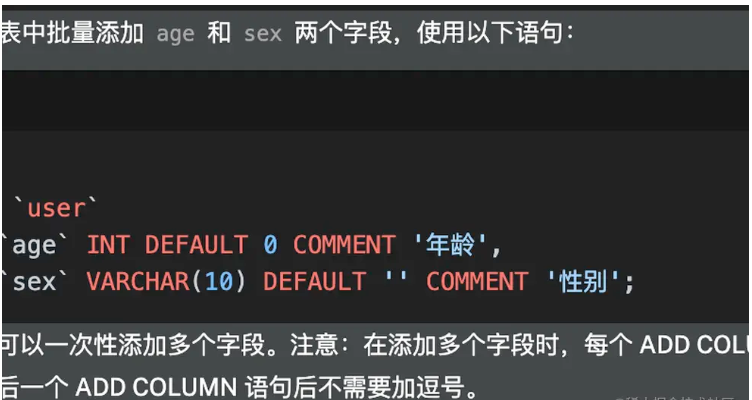

In MySQL, you can use the ALTER TABLE statement to add table fields. The following is some sample code to add multiple fields in batches:
ALTER TABLE `table_name` ADD COLUMN `new_column_name` `data_type` DEFAULT `default_value` COMMENT 'description';
Among them, table_name is the table name, new_column_name is the name of the newly added field, data_type is the data type of the new field, default_value is the default value of the new field, description is the description information of the new field.
For example, add a INT type field named age, its default value is 0, and the comment is age , you can use the following statement:
ALTER TABLE `user` ADD COLUMN `age` INT DEFAULT 0 COMMENT '年龄';
sql ALTER TABLE `table_name` ADD COLUMN `new_column_name1` `data_type1` DEFAULT `default_value1` COMMENT 'description1', ADD COLUMN `new_column_name2` `data_type2` DEFAULT `default_value2` COMMENT 'description2', ..., ADD COLUMN `new_column_nameN` `data_typeN` DEFAULT `default_valueN` COMMENT 'descriptionN';
For example, to add two fields age and sex in batches to the user table, use the following statement:
sql ALTER TABLE `user` ADD COLUMN `age` INT DEFAULT 0 COMMENT '年龄', ADD COLUMN `sex` VARCHAR(10) DEFAULT '' COMMENT '性别';
Use the above statement. Add multiple fields at once. Note: When adding multiple fields, each ADD COLUMN statement needs to end with a comma, and no comma is required after the last ADD COLUMN statement.
You can use the following two methods to add fields to multiple tables in MySQL:
Use the ALTER TABLE statement to add fields to each table one by one. The following is sample code:
sql -- 为表1添加字段 ALTER TABLE `table1` ADD COLUMN `new_column_name` `data_type` DEFAULT `default_value` COMMENT 'description'; -- 为表2添加字段 ALTER TABLE `table2` ADD COLUMN `new_column_name` `data_type` DEFAULT `default_value` COMMENT 'description'; -- 为表3添加字段 ALTER TABLE `table3` ADD COLUMN `new_column_name` `data_type` DEFAULT `default_value` COMMENT 'description';
This method is more cumbersome, but it is suitable for situations where only a small number of tables need to add fields.
sql -- 为表1添加字段 ALTER TABLE `table1` ADD COLUMN `new_column_name` `data_type` DEFAULT `default_value` COMMENT 'description'; -- 为表2添加字段 ALTER TABLE `table2` ADD COLUMN `new_column_name` `data_type` DEFAULT `default_value` COMMENT 'description'; -- 为表3添加字段 ALTER TABLE `table3` ADD COLUMN `new_column_name` `data_type` DEFAULT `default_value` COMMENT 'description';
Save the script as a .sql file, and then use MySQL client tools (such as MySQL Workbench) to run the script to batch multiple tables. Add fields.
When using a script to add fields in batches, you need to pay attention to the following points:
Make sure to back up the database before running the script to prevent accidental data loss.
Ensure that the field information in the script is correct, otherwise data errors or data loss may occur.
The script may take a long time to run, depending on the number of tables to which fields need to be added and the size of the tables.
MyBatis is a data access framework. It does not provide the function of directly adding table fields, and requires native SQL statements. to fulfill. Therefore, to add fields to multiple tables, you can follow the steps below:
In MyBatis, you can define SQL statements through annotations or XML files. For example, in an XML file, you can use the <update> tag to write a SQL statement. Here is the sample code:
<update id="addColumn" parameterType="map">
ALTER TABLE ${tableName} ADD COLUMN ${newColumnName} ${dataType} DEFAULT ${defaultValue};
</update> In this example, ${tableName} , ${newColumnName} , ${dataType} and ${defaultValue} are all parameters that need to be set dynamically in the code.
To execute SQL statements, Java code can use the SqlSession interface of MyBatis.
To execute a SQL statement, you first need to obtain the SqlSession object and call the corresponding method. The following is the sample code:
public void addColumn(String tableName, String newColumnName, String dataType, String defaultValue) {
try (SqlSession session = sqlSessionFactory.openSession()) {
Map<String, Object> params = new HashMap<>();
params.put("tableName", tableName);
params.put("newColumnName", newColumnName);
params.put("dataType", dataType);
params.put("defaultValue", defaultValue);
session.update("addColumn", params);
session.commit();
}
}In this example, sqlSessionFactory is an already created SqlSessionFactory object.
Finally, call Java code at the appropriate location in the application to execute SQL statements. Here is the sample code:
addColumn("table1", "new_column_name", "VARCHAR", "'default_value'");
addColumn("table2", "new_column_name", "INTEGER", "0");
addColumn("table3", "new_column_name", "DECIMAL(10,2)", "0.00");The above is the detailed content of What is the method to add fields in batches to Mysql table?. For more information, please follow other related articles on the PHP Chinese website!




